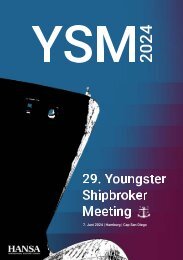HANSA 06-2019
Reparatur & Umbau | Start-Ups | COMPIT Review | CIMAC 2019 | Terminaltechnik | Batterien & Hybrid | Offshore-Flotte | U.A.E. | Cruise Ship Interiors | Zeaborn & Offen
Reparatur & Umbau | Start-Ups | COMPIT Review | CIMAC 2019 | Terminaltechnik | Batterien & Hybrid | Offshore-Flotte | U.A.E. | Cruise Ship Interiors | Zeaborn & Offen
Erfolgreiche ePaper selbst erstellen
Machen Sie aus Ihren PDF Publikationen ein blätterbares Flipbook mit unserer einzigartigen Google optimierten e-Paper Software.
Schiffstechnik | Ship Technology<br />
The group<br />
Fincantieri is one of the world’s<br />
largest shipbuilding groups with<br />
20 locations. Europe’s largest<br />
shipbuilder posted a turnover of<br />
almost € 5.5 billion in 2018, 9%<br />
more than in 2017. 35 ships were<br />
delivered by 15 shipyards, the<br />
annual surplus climbed 30% to €<br />
69 million. Last year alone, orders<br />
were received for 27 ships worth €<br />
8.6 billion, including 14 cruise<br />
ships for eight different customers.<br />
Among others, TUI Cruises<br />
switched from the Meyer shipyard<br />
in Turku to the Italians as a new<br />
customer. The total order book<br />
now contains 116 ships with €<br />
25.5 billion (+16%) in firm orders<br />
and a further € 8.3 billion in agreed<br />
newbuilding options. Cruise<br />
ships account for 54% of Group<br />
sales, naval ships for 24%.<br />
The Fincantieri subsidiary is based<br />
in Caneva, near Pordenone<br />
The factory<br />
Marine Interiors’ base in Caneva, near Pordenone, comprises offices and<br />
production, warehousing and logistics facilities on a site spanning 63,000 m2<br />
(including 30,000 indoors). An additional 7,500 m2 site in Pordenone,<br />
5,000 indoors, has a panel-production factory. Today the factory is producing<br />
12,000 cabins per year and 5,000 wet units and 40,000 m2 of public<br />
areas, serving the four shipyards in Monfalcone, Marghera, Ancona and<br />
Geneva plus Søviknes and Langsten in Norway. The breakdown (on revenue)<br />
is: 60% Italy, 30% Norway, 10% directly to the shipowners. The<br />
breakdown in volumes differs, because the cabins for the luxurary expedition<br />
vessels built in Norway have a higher price. Revenue of Marine Interiors<br />
rose from 30 mill. € in 2014 to more than 220 mill. € in 2018.<br />
© Marine Interiors<br />
as vary a lot, not least following architectural<br />
trends. »In this segment, you<br />
need to be flexible, therefore it is hard to<br />
establish a mass production«, the CEO<br />
states.<br />
»Made in Italy«<br />
According to Cafaro, MI is responsible<br />
for 90% of the cabins that Fincantieri is<br />
using, as well as for 30 to 40% of public<br />
areas.<br />
As it is with Papenburg-based Meyer<br />
Werft, Fincantieri relies on a network<br />
of regional and national suppliers, too, in<br />
case MI is not producing itself. 90% of the<br />
suppliers are located in Italy. Cafaro does<br />
not hide the fact that this structure can result<br />
in additional costs compared to suppliers<br />
from other regions. However, there<br />
is a certain commitment to the initiative<br />
»Made in Italy«. The sheer mass brings advantages<br />
in this respect, Cafaro says: »We<br />
have a long-lasting backlog, so we can leverage<br />
on our scale to obtain a »Made in Italy«<br />
quality at a reasonable price.«<br />
From the factory, by far the largest<br />
share of kits and modules are transported<br />
in containers on the road to the shipyards.<br />
In terms of the logistic chain to the Norwegian<br />
sites, it is around 90%. The rest<br />
is done either by the cruise vessels themselves<br />
when shifting from one production<br />
facility to the yard of final outfitting or<br />
sometimes with smaller container vessels.<br />
Special attention to China<br />
The likewise growing and complex market<br />
China is a very special case – for the<br />
whole cruise industry and Fincantieri, respectively.<br />
The Italians are active with a<br />
joint venture (see box) and want to participate<br />
in the boom of the local cruise industry.<br />
In February, Fincantieri delivered<br />
the first vessels designed especially for the<br />
Asian market, the »Costa Venezia«.<br />
It was like entering a new market.<br />
»Everything goes down to what the ship is<br />
for. It is completely different to entertain<br />
a Chinese. Even the distribution of public<br />
areas is completely different. You have<br />
more gaming areas, different restaurants,<br />
different open spaces«, the CEO emphasizes.<br />
In the medium term, the joint venture<br />
intends to build ships in China with<br />
China-based suppliers. Cafaro says, MI<br />
will be active there: »We will and we are<br />
already structuring a team and the facilities<br />
to be serving the vessels being built<br />
there.« Until then, the Italians will deliver<br />
their interior products to the Far East.<br />
For the first vessels, the logistical process<br />
will be a careful mix, »we will need<br />
to be on the safe side to secure the supply<br />
chain«, what can be a headache, the CEO<br />
adds. So in the beginning, the modules<br />
will be shipped by vessels from Europe<br />
to China. »But of course, when the market<br />
goes up and more vessels will be built<br />
here, we will be more and more establishing<br />
a stance in China.«<br />
More growth potential<br />
Besides the geographical aspects, Cafaro<br />
has more growth potential in mind. First,<br />
there is the interior market itself, in which<br />
MI would like to add further products to<br />
its portfolio. »We are looking carefully to<br />
the development of a plan for galleys. In<br />
terms of production, what we can change<br />
is to increase the production of the panels<br />
also for the wet units and not only for<br />
the cabins. Then we are looking around<br />
to grow our group with adjacent business,<br />
such as glazing, which could be interesting<br />
for us«, he summarizes. Second, the<br />
management sees a growing demand for<br />
the refurbishment of older cruise tonnage.<br />
An increasing number of clients ask<br />
for a corresponding service, as new regulation<br />
comes into force, passengers ask for<br />
modern equipment and the market is still<br />
booming. »We want to grow in this industry<br />
as well«, Cafaro says with a glimpse<br />
beyond existing structures, »even if<br />
the vessels were not built by Fincantieri,<br />
originally.« <br />
n<br />
<strong>HANSA</strong> International Maritime Journal <strong>06</strong> | <strong>2019</strong><br />
31


















